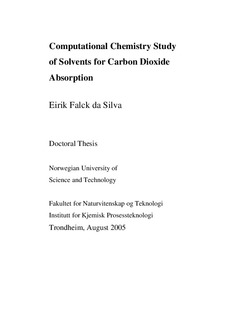| dc.contributor.author | da Silva, Eirik Falck | nb_NO |
| dc.date.accessioned | 2014-12-19T13:10:53Z | |
| dc.date.available | 2014-12-19T13:10:53Z | |
| dc.date.created | 2006-02-10 | nb_NO |
| dc.date.issued | 2005 | nb_NO |
| dc.identifier | 125828 | nb_NO |
| dc.identifier.isbn | 82-471-7182-1 | nb_NO |
| dc.identifier.uri | http://hdl.handle.net/11250/244514 | |
| dc.description.abstract | Absorption with aqueous amine solvents is at present the most viable technology for CO2 capture. While this is a proven technology, efforts are ongoing to improve it in order to make it a more attractive technology for large scale use to reduce CO2 emissions. Finding solvents with better properties is one approach to improving the technology.
In this thesis methods in computational chemistry are used to improve the understanding of the chemistry of CO2 absorption in amine-water systems. The work is also intended to provide models that can be used to predict the performance of new solvents. Such predictive models are intended to facilitate the screening for new solvents.
The main focus of the computational chemistry work has been to model solvent effects. Most of the work has been based on use of quantum mechanical calculations to determine gas phase properties and different models to determine the solvation energy. Most of the solvation energy calculations have been based on molecular simulations and continuum models. In addition solvation energies calculated with the RISM-SCF model have been studied.
The reaction mechanisms of the process have been studied in detail. Calculations have been used to attempt to resolve uncertainties regarding mechanisms. The work is in most cases in agreement with the consensus in the literature, but it is concluded that carbamate formation is most likely to be a single-step mechanism. From the study of reaction mechanisms it is concluded that the reactivity of an amine solvent with CO2 is governed by two equilibrium constants: the base stability and carbamate stability.
These two equilibrium constants have been modeled with gas phase quantum mechanical calculations and different solvation models. Comparison with experimental data suggests that both equilibrium constants can be modeled with a semi-quantitative accuracy. The models are not entirely accurate but do mostly capture trends observed in experimental data.
In addition to the equilibrium constants there are other properties that may affect the overall performance and viability of a solvent in large scale industrial use. These properties are also discussed and the possibility of modeling them is assessed.
The ideal values for the main equilibrium constants are unknown and the present work does therefore not reach any specific conclusions on what the ideal solvent is. This thesis does however offer a fairly detailed plan of how to find optimal solvents and tools to carry out the screening. | nb_NO |
| dc.language | eng | nb_NO |
| dc.publisher | Fakultet for naturvitenskap og teknologi | nb_NO |
| dc.relation.ispartofseries | Doktoravhandlinger ved NTNU, 1503-8181; 2005:148 | nb_NO |
| dc.relation.haspart | da Silva, EF; Svendsen, HF. Prediction of the pKa Values of Amines Using ab Initio Methods and Free-Energy Perturbations. Ind. Eng. Chem. Res. 42: 4414-4421, 2003. | nb_NO |
| dc.relation.haspart | da Silva, EF; Svendsen, HF. Ab Initio Study of the Reaction of Carbamate Formation from CO2 and Alkanolamines. Ind. Eng. Chem. Res.. 43: 3413-3418, 2004. | nb_NO |
| dc.relation.haspart | da Silva, EF. Use of free energy simulations to predict infinite dilution activity coefficients. Fluid Phase Eq.. 221: 15-24, 2004. | nb_NO |
| dc.relation.haspart | da Silva, EF. Comparison of Quantum Mechanical and Experimental Gas-Phase Basicities of Amines and Alcohols. J. Phys. Chem. A. 109: 1603-1607, 2005. | nb_NO |
| dc.relation.haspart | da Silva, EF; Svendsen, HF. Study of the Carbamate Stability of Amines Using ab Initio Methods and Free-Energy Perturbations. Ind. Eng. Chem. Res., 2005. | nb_NO |
| dc.relation.haspart | da Silva, EF; Kuznetsova, T; Kvamme, B. Molecular Dynamics Study of Ethanolamine as a Pure Liquid and in Aqueous Solution. . | nb_NO |
| dc.relation.haspart | da Silva, EF; Yamazaki, T; Hirata, F. Comparison of Solvation Models in the Calculation of Amine Basicity. . | nb_NO |
| dc.title | Computational Chemistry Study of Solvents for Carbon Dioxide Absorption | nb_NO |
| dc.type | Doctoral thesis | nb_NO |
| dc.contributor.department | Norges teknisk-naturvitenskapelige universitet, Fakultet for naturvitenskap og teknologi | nb_NO |
| dc.description.degree | dr.ing. | nb_NO |
| dc.description.degree | dr.ing. | en_GB |
